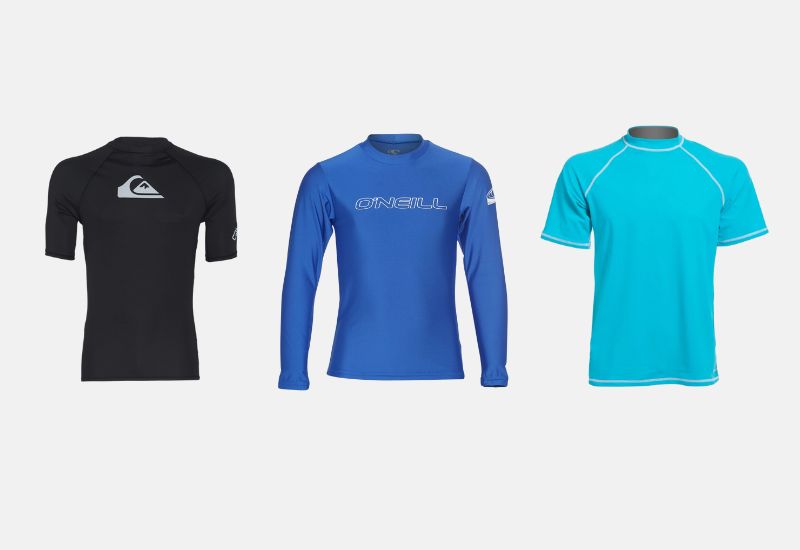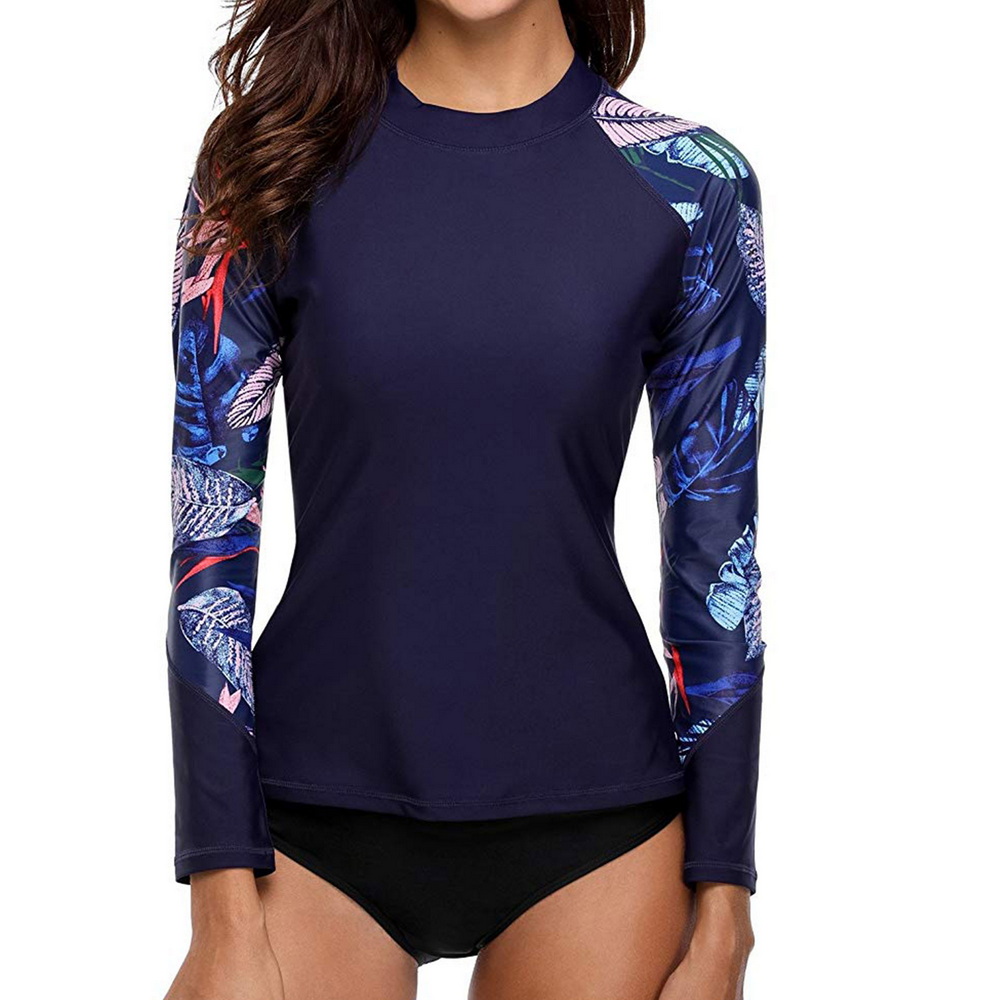Content Menu
● Understanding Rash Guards
● Sun Protection: Your Skin's Best Friend
● Comfort and Chafing Prevention
● Temperature Regulation
● Enhanced Performance and Mobility
● Modesty and Confidence Boost
● Protection from Marine Life
● Style and Versatility
● Environmental Considerations
● Videos
● Conclusion
● Frequently Asked Questions
>> 1. Q: Can I wear a rash guard for activities other than swimming?
>> 2. Q: How do I choose the right size rash guard?
>> 3. Q: Are rash guards only for surfing?
>> 4. Q: How do I care for my rash guard to ensure it lasts?
>> 5. Q: Can rash guards replace sunscreen entirely?
In recent years, rash guard swimwear has gained immense popularity among water sports enthusiasts, beachgoers, and casual swimmers alike. This versatile piece of swimwear offers a multitude of benefits that extend far beyond its original purpose of preventing skin irritation for surfers. In this comprehensive guide, we'll explore the numerous reasons why wearing a rash guard swimwear is not just a fashion statement but a practical choice for anyone spending time in or around water.
Understanding Rash Guards
Before delving into the benefits, let's first understand what a rash guard is. A rash guard, also known as a rashie or swim shirt, is a form-fitting athletic shirt made from spandex and nylon or polyester. Originally designed for surfers, these garments have evolved to become an essential piece of swimwear for various water activities.

Sun Protection: Your Skin's Best Friend
One of the primary reasons to wear a rash guard is the exceptional sun protection it provides. Most rash guards are designed with a high Ultraviolet Protection Factor (UPF), often ranging from 30 to 50+. This means they block out a significant portion of the sun's harmful UV rays, reducing your risk of sunburn, skin damage, and long-term health concerns like skin cancer.
Unlike sunscreen, which needs to be reapplied frequently and can wash off in water, a rash guard provides consistent protection throughout your time outdoors. This is particularly beneficial for those who spend extended periods in the water or engage in activities where reapplying sunscreen is impractical.

Comfort and Chafing Prevention
The name "rash guard" originates from its initial purpose – to protect surfers from the chafing caused by their surfboards. This benefit extends to all water activities. Whether you're swimming, paddleboarding, or engaging in any water sport, a rash guard acts as a barrier between your skin and potential irritants like sand, salt water, and rough surfaces.
The snug fit of a rash guard reduces friction and prevents the uncomfortable rubbing that can occur with loose clothing or direct skin contact with equipment. This makes your water experience more enjoyable and allows you to focus on your activity rather than discomfort.
Temperature Regulation
Rash guards are not just for warm weather. They come in various thicknesses and sleeve lengths, making them suitable for different water temperatures. In cooler waters, a long-sleeve rash guard can provide an extra layer of insulation, helping to retain body heat and extend your time in the water comfortably.
Conversely, in warmer conditions, rash guards made from lightweight, breathable materials can help keep you cool by wicking away moisture and providing shade for your skin. This versatility makes rash guards an excellent choice for year-round water activities.
Enhanced Performance and Mobility
For athletes and water sports enthusiasts, rash guards offer performance benefits. The stretchy, form-fitting nature of these garments allows for a full range of motion without the drag or resistance that looser clothing might create in the water. This can be particularly advantageous for swimmers, surfers, and water aerobics participants who need unrestricted movement.
Additionally, the quick-drying properties of rash guard materials mean you're not weighed down by water-logged clothing, allowing for better agility and comfort both in and out of the water.

Modesty and Confidence Boost
For many individuals, rash guards provide a welcome layer of modesty. They offer more coverage than traditional swimwear, which can be particularly appealing for those who feel self-conscious about their bodies or prefer a more conservative beach look. This added coverage can boost confidence, allowing people to enjoy water activities without feeling exposed or uncomfortable.
Rash guards come in a variety of styles, from sleeveless to long-sleeved, and can be paired with swim bottoms of your choice, offering flexibility in how much skin you want to show.

Protection from Marine Life
For those swimming in natural bodies of water, rash guards can provide a layer of protection against minor encounters with marine life. While they won't shield you from serious hazards, they can help prevent minor stings from jellyfish or scrapes from coral reefs. This added protection can give swimmers more peace of mind when exploring ocean environments.
Durability and Cost-Effectiveness
Investing in a quality rash guard can be more cost-effective in the long run compared to relying solely on sunscreen. While the initial cost might be higher, a good rash guard can last for several seasons with proper care. When you consider the amount of sunscreen you might use over a summer of frequent beach visits or water activities, the rash guard often proves to be a more economical choice.
Moreover, the durability of rash guards means they can withstand the harsh effects of salt water, chlorine, and sun exposure better than many traditional swimwear materials, maintaining their shape and protective properties over time.
Style and Versatility
Gone are the days when rash guards were purely functional. Today, they come in a wide array of colors, patterns, and designs, allowing wearers to express their personal style while enjoying the practical benefits. From solid colors to vibrant prints, there's a rash guard to suit every taste.
The versatility of rash guards extends beyond water activities. They can be worn as a stylish layer for beach outings, paired with shorts for a casual look, or even used as a lightweight top for outdoor activities like hiking or running on cooler days.

Environmental Considerations
Choosing to wear a rash guard can also be an environmentally conscious decision. By reducing the need for chemical sunscreens, which can be harmful to marine ecosystems, particularly coral reefs, rash guard wearers contribute to the protection of aquatic environments. This aligns with the growing trend of eco-friendly and sustainable approaches to beach and water activities.
Videos
To further illustrate the benefits and uses of rash guard swimwear, let's take a look at some video content:
1. "Top Reasons Why Every Gi-wearer Must Own A Rash Guard" - While this YouTube video focuses on rash guards for martial arts, many of the benefits discussed apply to water activities as well. Watch it here:
2. "What is a Rashguard? - MMA Education" - This informative video provides a comprehensive overview of rash guards, their uses, and benefits.
Conclusion
In conclusion, wearing a rash guard swimwear offers a multitude of benefits that cater to comfort, protection, performance, and style. Whether you're a professional athlete, a casual beachgoer, or someone looking for added sun protection, a rash guard is a versatile and practical addition to your swimwear collection. As awareness of sun safety and the desire for comfortable, functional swimwear grows, it's likely that rash guards will continue to gain popularity among all types of water enthusiasts.
Frequently Asked Questions
1. Q: Can I wear a rash guard for activities other than swimming?
A: Absolutely! Rash guards are versatile and can be worn for various outdoor activities like hiking, running, or even as a casual top. Their quick-drying and sun-protective properties make them suitable for many scenarios beyond water sports.
2. Q: How do I choose the right size rash guard?
A: Rash guards should fit snugly but not be overly tight. Look for a fit that allows full range of motion without riding up. Most brands provide size charts based on chest measurements. When in doubt, it's often better to size up for comfort.
3. Q: Are rash guards only for surfing?
A: While originally designed for surfing, rash guards are now used for a wide range of water activities including swimming, snorkeling, paddleboarding, and even beach volleyball. They're beneficial for anyone spending time in or around water.
4. Q: How do I care for my rash guard to ensure it lasts?
A: Rinse your rash guard in fresh water after each use, especially if worn in saltwater or chlorine. Wash it in cold water with mild detergent, and avoid using fabric softeners. Air dry your rash guard away from direct sunlight to preserve its color and elasticity.
5. Q: Can rash guards replace sunscreen entirely?
A: While rash guards provide excellent sun protection for the areas they cover, it's still important to use sunscreen on exposed skin. Use sunscreen on your face, hands, and any other uncovered areas for complete protection.






































